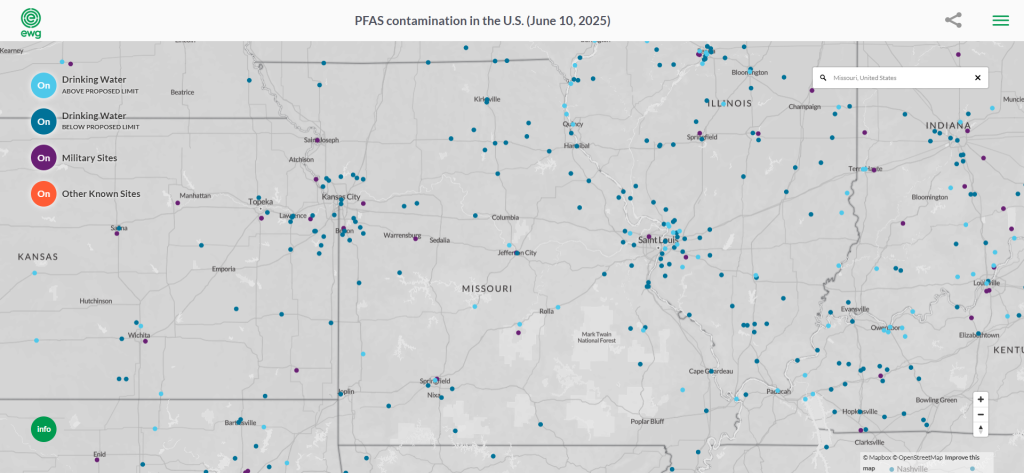- Home
- Personal Injury
- PFAS Lawsuit
- PFAS Contamination Map
- PFAS in Missouri
PFAS in Missouri
- Last updated: July 16, 2025
-
Contributor: nicky

I have investigated PFAS contamination in Missouri, where these pervasive chemicals have been detected in drinking water, soil, and industrial sites, drawing increasing concern from state and federal agencies. PFAS (per- and polyfluoroalkyl substances) are a family of nearly 9,000 human-made compounds that do not easily break down in the environment. I have found that their persistence, coupled with possible links to cancer, immune suppression, and other health effects, has prompted closer scrutiny from the Environmental Protection Agency (EPA), the Missouri Department of Natural Resources (DNR), and local communities. As I learned more about how these chemicals enter Missouri’s water and soil, the risks for long-term contamination became clear, especially for residents living near airports, military sites, or large industrial facilities.
What are PFAS and why are they dangerous?
PFAS include numerous chemicals such as PFOA and PFOS, once widely used in products like non-stick cookware, firefighting foams, and water-resistant fabrics. According to the U.S. Centers for Disease Control and Prevention (CDC), 97% of Americans have detectable levels of PFAS in their blood, demonstrating just how widespread these chemicals have become in daily life. Although older versions like PFOS and PFOA have been largely phased out of manufacturing, they remain in water, soil, and even the air because of their extraordinary durability.
Scientists have confirmed that newer PFAS can be just as persistent and toxic as the older forms. Independent research suggests that PFAS exposure may contribute to certain cancers, elevated cholesterol, thyroid disruption, and impaired immune response. The National Toxicology Program noted that PFOA and PFOS can suppress the body’s antibody response. Because of these findings, Missouri residents who come into contact with PFAS, whether through tap water, food packaging, or direct industrial exposure, could face serious health challenges.
Where are PFAS found in Missouri?
I have discovered that known PFAS hotspots occur in several parts of Missouri, though not all contamination levels are publicly confirmed. Military bases, airports, and industrial areas have drawn particular attention because these sites may store or use PFAS-containing firefighting foams. Certain manufacturing plants handling plastics, metal coatings, or electronics also risk releasing PFAS into local waterways.
Additionally, sites undergoing redevelopment, such as Brownfields, have tested positive for PFAS chemicals in the past. These findings align with nationwide patterns—PFAS have been found at various Department of Defense sites, leading federal authorities to prioritize remediation or further investigation. The Missouri DNR, meanwhile, continues to monitor soil and water near industrial zones to better understand how widespread PFAS contamination might be.
PFAS in Missouri’s drinking water
Across the state, PFAS are being detected in drinking water systems at levels ranging from below detection to above health advisory thresholds set by the EPA. Although the EPA’s health advisories for PFOA and PFOS are currently non-enforceable, they reflect increasing recognition that even minute concentrations could pose health risks.
Affected areas and water utilities
My review of public utility reports showed that several water systems in Missouri either tested voluntarily for PFAS or did so under EPA-led monitoring initiatives. Missouri American Water, for example, has conducted sampling to assess whether PFOA, PFOS, or similar chemicals exceed the latest federal health advisories. Other municipal utilities have begun sharing PFAS sampling data in their Consumer Confidence Reports, allowing residents to see if their local water supply surpassed the suggested limits.
While contamination levels vary, certain areas downstream from industrial points or near firefighting foam usage are more susceptible. In neighboring states, PFAS contamination often clusters near large airports or military airfields, so I have watched for similar patterns in Missouri.
PFAS sources: Firefighting foam, industry, military facilities
Firefighting foam (AFFF) is one of the most well-documented sources of PFAS water pollution. This foam is frequently used at airports, chemical plants, and oil refineries to extinguish high-heat fires. The Illinois Attorney General’s lawsuits, for instance, illustrate how AFFF use can contaminate groundwater, prompting concerns for Missouri’s airports and industrial sites. According to the research I reviewed, Missouri also has setup sites, including military bases, where AFFF may have been stored or used.
Manufacturing and industrial activities can also release PFAS through disposal processes or wastewater discharges. Data collected by a multi-state workgroup (including 18 states and federal partners) identified industries such as waste disposal, metal finishing, and chemical manufacturing as primary PFAS sources. Their combined findings highlight that without robust source control, PFAS could continually enter the environment even if companies reduce their usage over time.
EPA and Missouri Department of Natural Resources test results
The EPA’s Third Unregulated Contaminants Monitoring Rule (UCMR 3), conducted from 2013 to 2015, showed no PFAS sample results above the old 70 parts per trillion (ppt) health advisory level in Missouri. However, new advisories for PFOA and PFOS are now set at levels too small to detect using standard testing. This shift in federal guidance reveals that even low levels of PFAS may warrant action.
The Missouri DNR has launched a workgroup to track federal PFAS research and develop local strategies. Its approach currently relies on EPA guidelines, which include the PFAS Strategic Roadmap focusing on research, restriction, and remediation. State officials report that more rigorous sampling is planned under UCMR 5 to capture current PFAS levels in public water systems.
PFAS in Missouri’s soil and agriculture
PFAS have also been identified in soil, farmland, and agricultural areas, raising concerns about crops and livestock. Because PFAS can persist in water sources and bioaccumulate in plants and animals, agricultural communities may be affected if contaminated water is used for irrigation or livestock.
PFAS in soil and food production
I have reviewed sources indicating that PFAS can remain in soil for extended periods, posing a risk for farmers who rely on local groundwater or surface water. In states like New Mexico, dairy farmers have disposed of thousands of gallons of milk daily due to PFAS contamination, allegedly traced back to firefighting foam. Similar stories have emerged across the U.S., raising questions about whether Missouri’s agricultural sector might face PFAS-related setbacks if contamination levels increase.
Furthermore, packaging used for produce or meat sometimes contains PFAS coatings to repel grease or moisture. Independent tests have discovered PFAS in food wrappers at pastry shops and burger chains. This can create an additional route of exposure, although the most critical concern remains PFAS-laden water or soil directly used for farming.
Risk to crops and animal products
Studies show that certain plants can absorb PFAS from irrigation water or soil. If these chemicals are present in feed, livestock may accumulate PFAS in their tissues, which then travel up the food chain. People in Missouri who consume local produce or meat may inadvertently ingest low levels of these chemicals over time. The University of Missouri, in partnership with state officials, continues to investigate whether PFAS is reaching local food supplies at harmful levels.
Health effects of PFAS exposure
Access to safe water and food is paramount because PFAS exposure carries a range of possible health risks:
- Cancer: Some types of PFAS, like PFOA and PFOS, have been associated with higher rates of kidney and testicular cancers.
- Immune disruption: Individuals with elevated PFAS levels may experience a suppressed immune response, which can reduce the effectiveness of vaccines and weaken overall immunity.
- Metabolic and endocrine impacts: PFAS have been linked to thyroid disorders, high cholesterol, and other metabolic conditions.
- Developmental risks: Researchers warn that children exposed to PFAS in utero or through childhood might experience developmental or learning difficulties, raising concerns about the long-term impact of these chemicals on developing brains.
Ongoing scientific work continues to parse out the exact correlation between PFAS exposure and disease onset. However, the EPA and other agencies agree that limiting PFAS levels is prudent, especially if contamination sources are identified and can be controlled or remediated.
Diseases linked to PFAS in Missouri
I have found multiple sources connecting PFAS exposure to a broad range of health issues. While each person’s susceptibility varies based on genetics and other environmental factors, experts stress the need for caution when traces of PFAS exceed recommended guidelines.
Kidney cancer
Kidney cancer is among the most noted outcomes linked to chronic PFAS exposure. The Environmental Working Group cites multiple studies suggesting a correlation between PFAS exposure and renal tumors. Individuals who live near industrial discharges or use private wells in affected areas might be more susceptible to these risks.
Testicular cancer
Testicular cancer is another potential consequence. Research has revealed that certain PFAS chemicals can enter and accumulate in reproductive tissues. I have read studies from the National Toxicology Program that highlight how these chemicals might disrupt normal hormone signaling, although more data is needed to confirm the precise mechanisms.
Liver disease
PFAS can strain the liver because these chemicals are not broken down effectively, allowing them to accumulate in bodily tissues. Elevated liver enzymes and fatty liver disease have been reported in populations with higher PFAS exposures. The Missouri DNR has acknowledged that individuals living close to industrial dumping grounds or AFFF training sites should take note of these risks.
Thyroid disorders
Thyroid dysfunction is another known health consequence. People exposed to PFAS over a long period can develop hyperthyroidism or hypothyroidism more frequently. This effect is believed to stem from how PFAS can mimic or interfere with certain hormones, affecting the thyroid gland’s normal function.
Reproductive and developmental issues
Developing fetuses and young children risk adverse outcomes from PFAS. Some studies focus on neurological development, learning capabilities, and immune system maturity. High PFAS levels might alter children’s response to vaccines or impede healthy brain growth, though outcomes vary from one individual to another.
How is Missouri responding to PFAS contamination?
In my view, Missouri’s response to PFAS contamination is still unfolding. While some communities actively test and remediate PFAS, others are in a holding pattern, awaiting new federal regulations or further EPA guidance. This patchwork approach can create confusion among residents who want to know whether their water is safe and how they can protect their families.
Missouri DNR monitoring programs
The Missouri DNR has formed a PFAS workgroup within its Division of Environmental Quality. This group monitors emerging science, gathers local data, and reports any findings to stakeholders. For instance, DNR tracks PFAS in Brownfields and defense restoration sites like Fort Leonard Wood Army Training Center and Lambert-St. Louis Air National Guard Base. Agency officials say they expect more detailed sampling results as the EPA’s UCMR 5 program proceeds.
EPA guidance in Missouri
Missouri relies heavily on the EPA’s PFAS Strategic Roadmap, which outlines plans to research, restrict, and remediate these chemicals. As part of the Roadmap, the EPA works with state agencies to identify contaminated sites and compel industries to address PFAS sources at the permit stage. Current health advisory levels for PFOA (0.004 ppt) and PFOS (0.02 ppt) in drinking water are well below standard detection methods, putting added pressure on state and local officials to keep up with evolving science and technology.
Local government responses and public testing
Local governments sometimes coordinate testing efforts when residents express concerns about well water, farmland, or community drinking water systems. Communities near airports, defense sites, or industrial complexes have conducted targeted testing on wells to ascertain whether PFAS levels surpass recommended thresholds. Some municipalities have also proposed installing filtration systems, such as granular activated carbon or reverse osmosis, to reduce PFAS in public supplies.
Can you test your water or soil for PFAS in Missouri?
As of now, private well owners can hire accredited labs to test water samples for PFAS. Although costs vary, many labs follow EPA-approved methods to analyze water or soil. If I had a private well near a known contamination source—such as an airport, factory, or military training ground—I would consider professional testing. The Missouri DNR website lists certified testing facilities and offers guidance on sample collection procedures.
Because PFAS are detected at extremely low concentrations, results may return as “non-detect” unless the lab offers highly sensitive analysis. Residents sometimes pool resources or pursue community-wide testing arrangements. Municipal or county officials can coordinate with local health departments to organize these efforts.
Do you qualify for a PFAS lawsuit in Missouri?
If you suspect PFAS contamination on your property or have developed health conditions possibly linked to PFAS exposure, you might qualify for a legal claim. Lawsuits typically require proof of contamination, evidence of direct exposure, and a medical diagnosis that aligns with PFAS-related health issues. For instance, I have read about a farmer forced to dispose of thousands of gallons of milk daily because PFAS-laden firefighting foam allegedly seeped into groundwater. In such a situation, a lawsuit often targets the foam’s manufacturer or the party responsible for the release.
Groundwater contamination cases have emerged in various states, including New Mexico and Illinois. Missouri has also seen increased interest in legal recourse, particularly from residents near defense sites or industrial areas. Some lawsuits focus on property damage, while others address personal injury claims like cancer, immune dysfunction, or thyroid disease. Those who believe they have a valid claim can speak with a specialized attorney for a free case review or consult organizations like Legal Claim Assistant to explore options.
Why choose Legal Claim Assistant
I understand how overwhelming it can feel to deal with water and soil contamination on your own. Legal Claim Assistant offers to connect you with experienced attorneys who focus on PFAS litigation. If you decide to take legal action, their network can help guide you through each step—from reviewing test data to filing a formal lawsuit. Having reliable support can be critical when tackling the complexities of environmental law and public health guidelines.
To learn more about available legal avenues, you can visit:
These resources outline how PFAS cases move forward, what types of damages you can pursue, and the kinds of medical documentation often required.
Frequently asked questions (FAQ)
Missouri residents frequently ask about the scope of PFAS contamination, health risks, and the potential for legal action. I have gathered the most common questions below.
PFAS have been detected in multiple locations, including Brownfields sites, defense installations, and certain water utilities’ sampling results. Contamination clusters often appear near industries known to handle PFAS, airports using firefighting foam, or waste disposal facilities. Results from past EPA monitoring (UCMR 3) did not show major exceedances of older thresholds, but new advisories are far more stringent than before.
You can contact a certified lab that specializes in PFAS analysis. Proper collection techniques are crucial, so I recommend following Missouri DNR’s instructions or lab-specific guidelines. You may also coordinate with local health departments or neighbors, because group testing can reduce costs.
Researchers have found possible links between PFAS exposure and kidney cancer, testicular cancer, thyroid dysfunction, reproductive issues, and immune system suppression. The National Toxicology Program also notes PFAS may reduce vaccine efficacy by hindering antibody production. However, risks differ based on exposure levels and individual susceptibility.
In many cases, yes. You may file a property damage or nuisance claim if PFAS contamination has affected your water supply, soil, or home value. Lawsuits typically name industrial polluters, manufacturers of PFAS-containing products, or other responsible parties. To establish a strong case, I recommend gathering water or soil test results as evidence.
If you or your property have been harmed by PFAS, you may qualify for legal action. Generally, you will need:
Confirmed PFAS levels above recommended limits, or a link between your health records and PFAS exposure
Evidence that a product, site, or entity is responsible for the contamination
Medical documentation of related illnesses (for personal injury claims)
Consulting with a lawyer is often the best step. If you are uncertain, you can explore options with the support of Legal Claim Assistant.
I have also seen people review PFAS contamination in other regions, such as Illinois or Colorado, to understand how different states handle similar issues. This comparison can be helpful when deciding whether or not to pursue legal avenues. By staying informed and acting decisively, you may be able to safeguard your health, protect your property, and seek redress if PFAS contamination has impacted your life.
Overview PFAS contamination in the USA
Here you van find the PFAS watercontamination map of the United States. Find, state by state, where water contamination has occurred due to PFAS exposure.
- PFAS in Alabama
- PFAS in Alaska
- PFAS in Arizona
- PFAS in Arkansas
- PFAS in California
- PFAS in Colorado
- PFAS in Connecticut
- PFAS in Delaware
- PFAS in Florida
- PFAS in Georgia
- PFAS in Hawaii
- PFAS in Idaho
- PFAS in Illinois
- PFAS in Indiana
- PFAS in Iowa
- PFAS in Kansas
- PFAS in Kentucky
- PFAS in Louisiana
- PFAS in Maine
- PFAS in Maryland
- PFAS in Massachusetts
- PFAS in Michigan
- PFAS in Minnesota
- PFAS in Mississippi
- PFAS in Missouri
- PFAS in Montana
- PFAS in Nebraska
- PFAS in Nevada
- PFAS in New Hampshire
- PFAS in New Jersey
- PFAS in New Mexico
- PFAS in New York
- PFAS in North Carolina
- PFAS in North Dakota
- PFAS in Ohio
- PFAS in Oklahoma
- PFAS in Oregon
- PFAS in Pennsylvania
- PFAS in Rhode Island
- PFAS in South Carolina
- PFAS in South Dakota
- PFAS in Tennessee
- PFAS in Texas
- PFAS in Utah
- PFAS in Vermont
- PFAS in Virginia
- PFAS in Washington
- PFAS in West Virginia
- PFAS in Wisconsin
- PFAS in Wyoming
Related Article

What Philips CPAP Machines Are Recalled and Why

